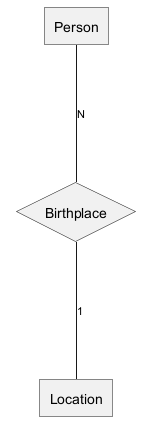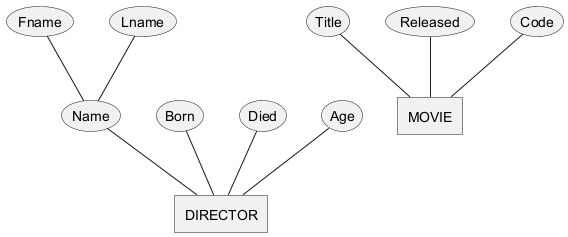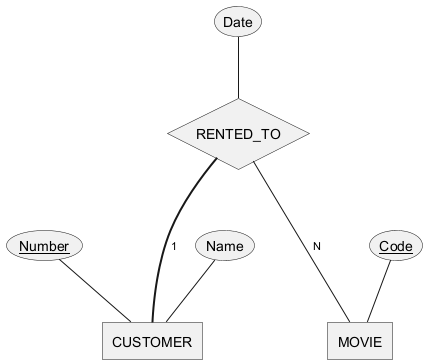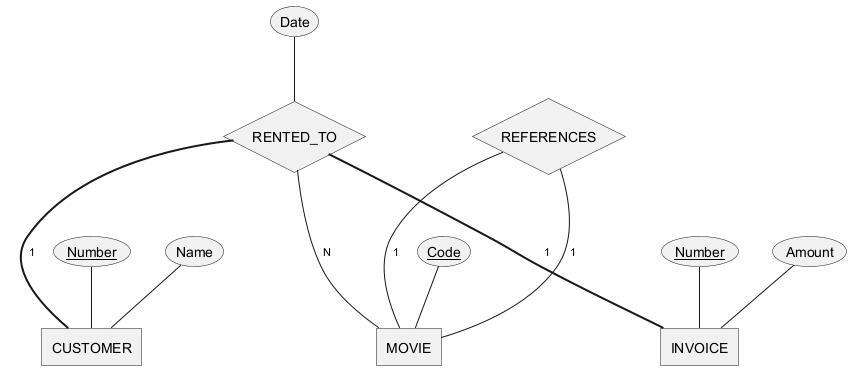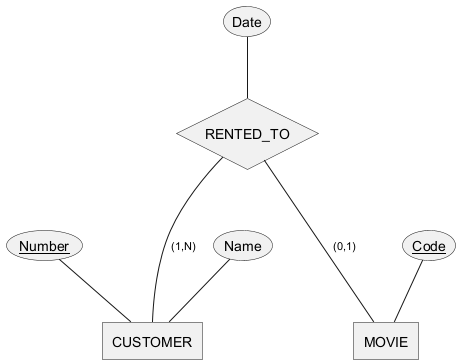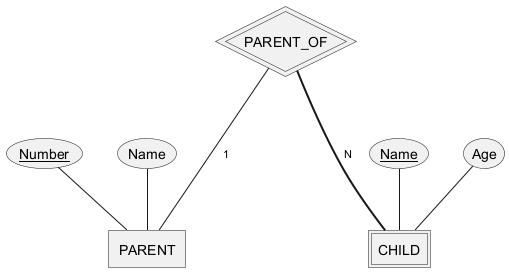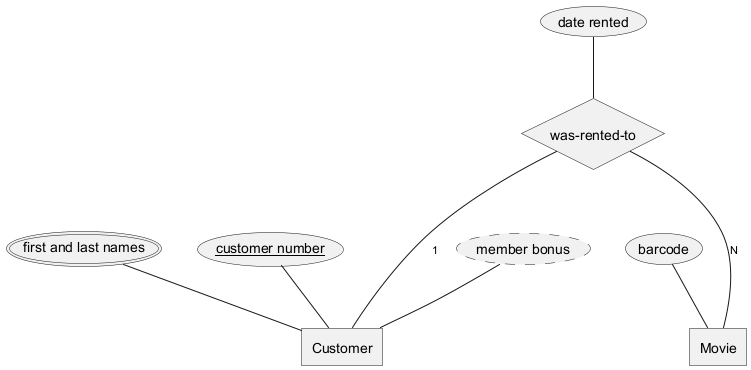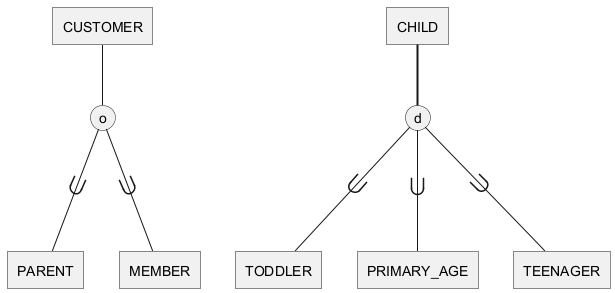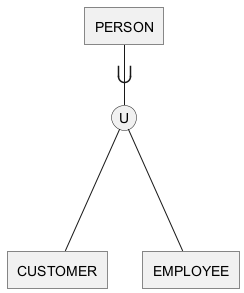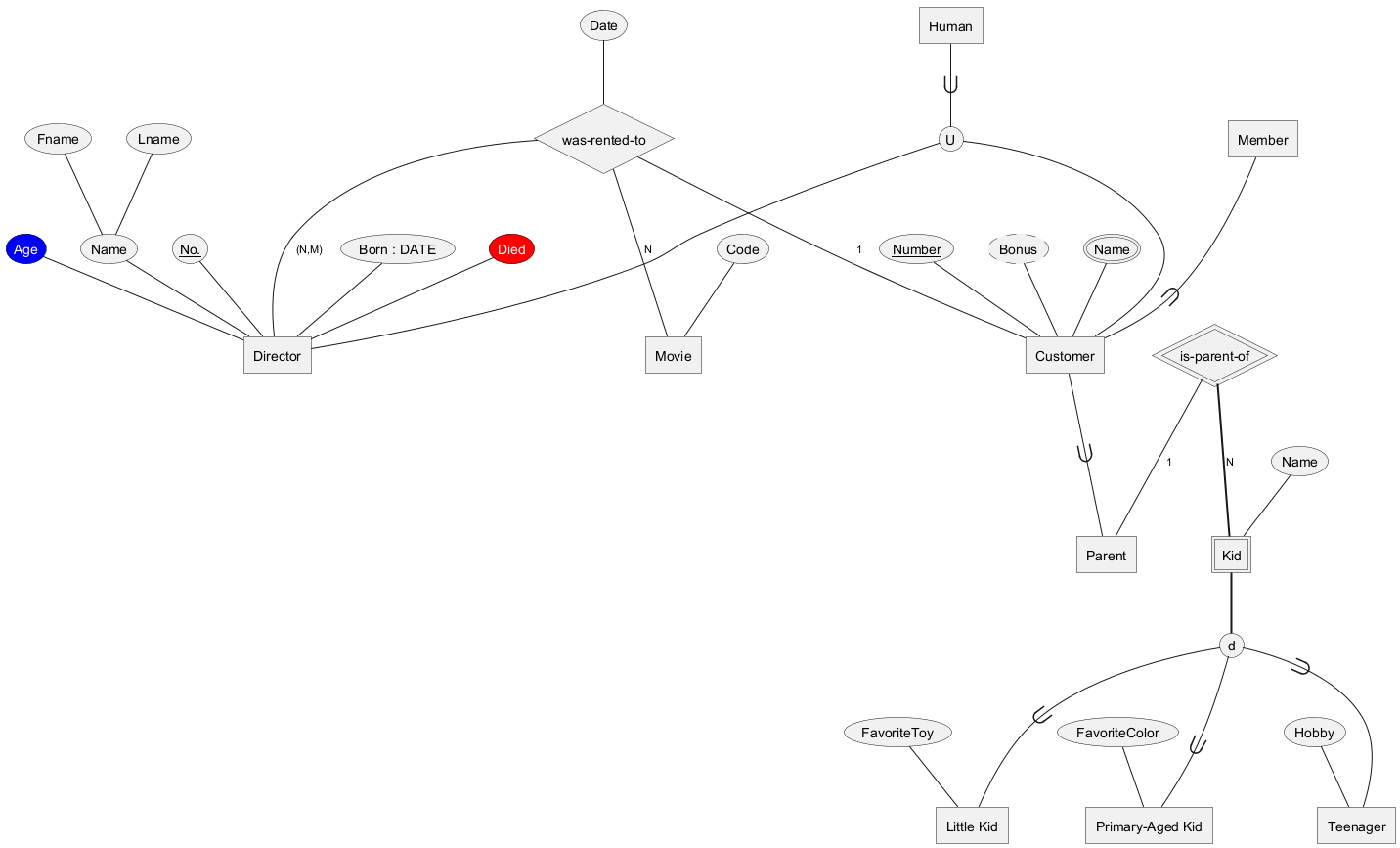This page is for Chen's
Entity Relationship notation, which is commonly used in teaching.
See also Information Engineering diagrams.
Entity Relationship (ER) diagrams are used to model databases at a conceptual level by describing entities, their attributes, and the relationships between them. In addition to basic relationships, PlantUML also supports subclasses and union types. This extended notation is sometimes referred to as Enhanced Entity Relationship (EER) or Extended Entity Relationship notation.
[Ref. GH-945 and GH-1718]
Vertical (by default)
|
🎉 Copied!


|
@startchen
entity Person {
}
entity Location {
}
relationship Birthplace {
}
Person -N- Birthplace
Birthplace -1- Location
@endchen
|
Horizontal
|
🎉 Copied!


|
@startchen
left to right direction
entity Person {
}
entity Location {
}
relationship Birthplace {
}
Person -N- Birthplace
Birthplace -1- Location
@endchen
|
[Ref. PR-1740]
Entities correspond to the "things" in your model. These can have
attributes that describe them and those attributes can be
composite (having nested attributes).
|
🎉 Copied!


|
@startchen
entity DIRECTOR {
Name {
Fname
Lname
}
Born
Died
Age
}
entity MOVIE {
Title
Released
Code
}
@endchen
|
Attributes can be
keys, meaning that their value is unique among entities of a given type, or they can be
derived, meaning that their value is computed based on other attributes. Attributes may also be
multi-valued, or have their
domain (set of allowed values) defined.
|
🎉 Copied!


|
@startchen
entity DIRECTOR {
Number : INTEGER <<key>>
Name {
Fname : STRING
Lname : STRING
}
Born : DATE
Died : DATE
Age : INTEGER
}
entity CUSTOMER {
Number : INTEGER <<key>>
Bonus : REAL <<derived>>
Name : STRING <<multi>>
}
@endchen
|
Relationships describe how entities are related to each other. These can be
one-to-one,
one-to-many, or
many-to-many. They can have
total participation (mandatory) or
partial participation (optional). Total participation is indicated using a double or thicker line. Relationships can also have attributes.
|
🎉 Copied!


|
@startchen
entity CUSTOMER {
Number <<key>>
Name
}
entity MOVIE {
Code <<key>>
}
relationship RENTED_TO {
Date
}
RENTED_TO =1= CUSTOMER
RENTED_TO -N- MOVIE
@endchen
|
Relationships are not limited to two entities.
|
🎉 Copied!


|
@startchen
entity CUSTOMER {
Number <<key>>
Name
}
entity MOVIE {
Code <<key>>
}
entity INVOICE {
Number <<key>>
Amount
}
relationship RENTED_TO {
Date
}
RENTED_TO =1= CUSTOMER
RENTED_TO -N- MOVIE
RENTED_TO =1= INVOICE
relationship REFERENCES {
}
REFERENCES -1- MOVIE
REFERENCES -1- MOVIE
@endchen
|
Structural constraints
The cardinality of relationships can also be expressed as a range.
|
🎉 Copied!


|
@startchen
entity CUSTOMER {
Number <<key>>
Name
}
entity MOVIE {
Code <<key>>
}
relationship RENTED_TO {
Date
}
RENTED_TO -(1,N)- CUSTOMER
RENTED_TO -(0,1)- MOVIE
@endchen
|
A
weak entity does not have a key attribute that uniquely identifies each instance of that entity. Instead, it is identified by the combination of a
partial key on the weak entity itself and the key of another entity, which it is related to via an
identifying relationship. A weak entity must have total participation in its identifying relationship.
|
🎉 Copied!


|
@startchen
entity PARENT {
Number <<key>>
Name
}
entity CHILD <<weak>> {
Name <<key>>
Age
}
relationship PARENT_OF <<identifying>> {
}
PARENT_OF -1- PARENT
PARENT_OF =N= CHILD
@endchen
|
Aliases
Entities, attributes and relationships can be given aliases to make the diagram more readable.
|
🎉 Copied!


|
@startchen
entity "Customer" as CUSTOMER {
"customer number" as Number <<key>>
"member bonus" as Bonus <<derived>>
"first and last names" as Name <<multi>>
}
entity "Movie" as MOVIE {
"barcode" as Code
}
relationship "was-rented-to" as RENTED_TO {
"date rented" as Date
}
RENTED_TO -1- CUSTOMER
RENTED_TO -N- MOVIE
@endchen
|
Entities can have
subclasses and
superclasses, much like in OOP, however a given subclass can have multiple superclasses. These are visually indicated using the subset symbol from set-theory.
|
🎉 Copied!


|
@startchen
entity CUSTOMER {
}
entity PARENT {
}
entity MEMBER {
}
CUSTOMER ->- PARENT
MEMBER -<- CUSTOMER
@endchen
|
We can show how the different subclasses of a given entity are related by combining the associations. They can be either
disjoint (one at a time) or
overlapping (multiple at the same time).
|
🎉 Copied!


|
@startchen
entity CUSTOMER {
}
entity PARENT {
}
entity MEMBER {
}
CUSTOMER ->- o { PARENT, MEMBER }
entity CHILD {
}
entity TODDLER {
}
entity PRIMARY_AGE {
}
entity TEENAGER {
}
CHILD =>= d { TODDLER, PRIMARY_AGE, TEENAGER }
@endchen
|
Categories or
union types are similar to subclasses and can be used to group together multiple related entities.
|
🎉 Copied!


|
@startchen
entity CUSTOMER {
}
entity EMPLOYEE {
}
entity PERSON {
}
PERSON ->- U { CUSTOMER, EMPLOYEE }
@endchen
|
|
🎉 Copied!


|
@startchen movies
<style>
.red {
BackGroundColor Red
FontColor White
}
.blue {
BackGroundColor Blue
FontColor White
}
</style>
entity "Director" as DIRECTOR {
"No." as Number <<key>>
Name {
Fname
Lname
}
Born : DATE
Died<<red>>
Age<<blue>>
}
entity "Customer" as CUSTOMER {
Number <<key>>
Bonus <<derived>>
Name <<multi>>
}
entity "Movie" as MOVIE {
Code
}
relationship "was-rented-to" as RENTED_TO {
Date
}
RENTED_TO -1- CUSTOMER
RENTED_TO -N- MOVIE
RENTED_TO -(N,M)- DIRECTOR
entity "Parent" as PARENT {
}
entity "Member" as MEMBER {
}
CUSTOMER ->- PARENT
MEMBER -<- CUSTOMER
entity "Kid" as CHILD <<weak>> {
Name <<key>>
}
relationship "is-parent-of" as PARENT_OF <<identifying>> {
}
PARENT_OF -1- PARENT
PARENT_OF =N= CHILD
entity "Little Kid" as TODDLER {
FavoriteToy
}
entity "Primary-Aged Kid" as PRIMARY_AGE {
FavoriteColor
}
entity "Teenager" as TEEN {
Hobby
}
CHILD =>= d { TODDLER, PRIMARY_AGE, TEEN }
entity "Human" as PERSON {
}
PERSON ->- U { CUSTOMER, DIRECTOR }
@endchen
|
